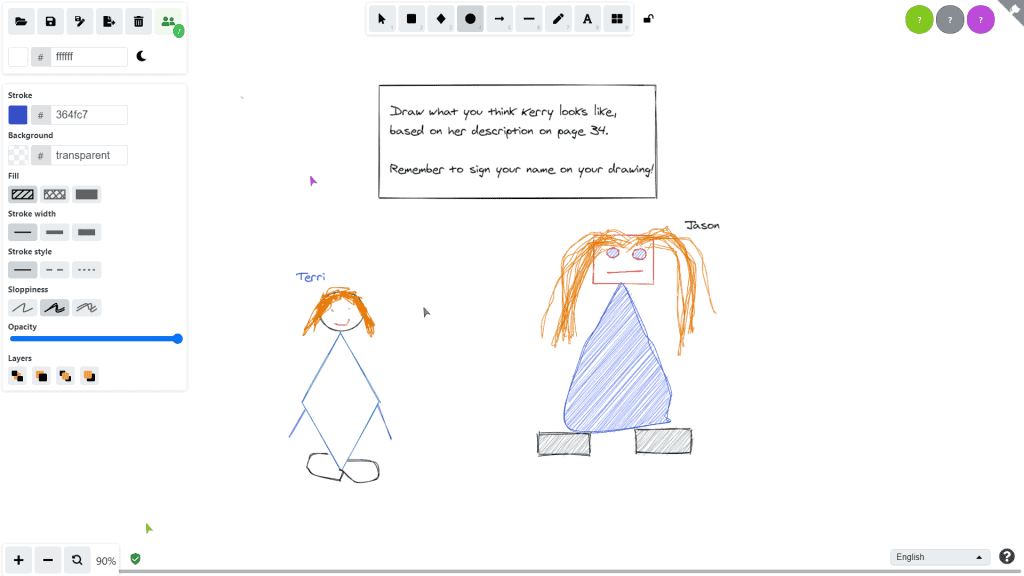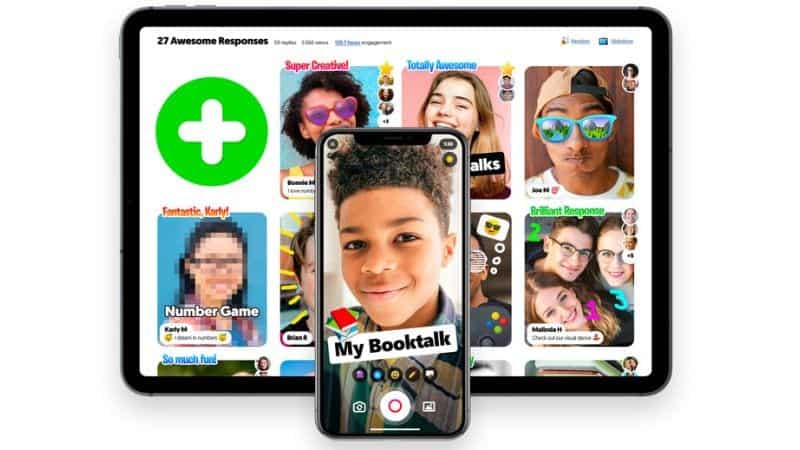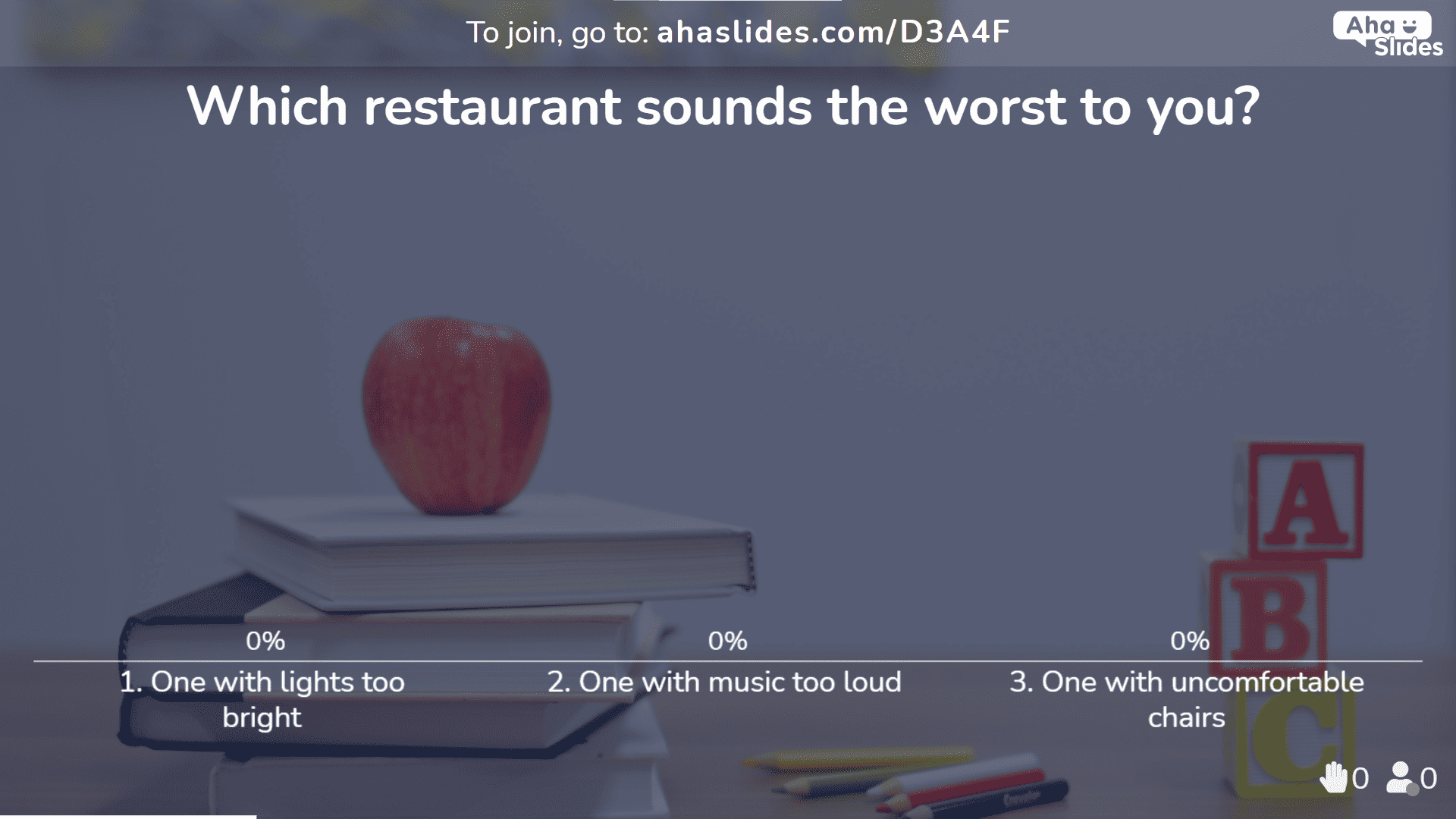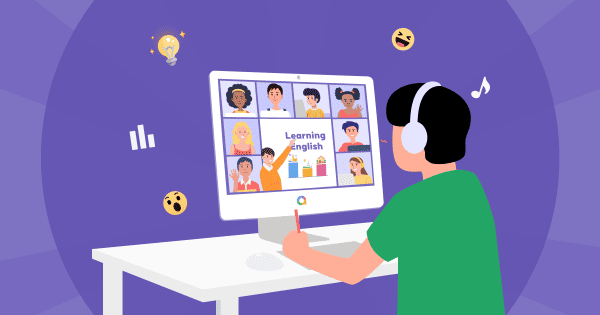New to online teaching? The pros and cons of e-learning can be a little unclear at first.
Still, with our classrooms and our world getting ever more remote, there’s never been a better time to learn the what, why and how of digital education.
Here’s a bumper list of 20 pros and cons of e-learning in a live virtual classroom, as well as 4 free tools that can help your classes engage more remote students!
Your Guide to the Pros and Cons of E-Learning
The 12 Pros of E-Learning
1. Flexibility
Let’s start with the obvious, shall we?
The ability to learn from absolutely anywhere, without the need to commute, is probably one of the biggest benefits of e-learning.
It’s an absolute lifeline to students who…
- Live in remote areas.
- Have to get public transport to school.
- Should be closer to home for medical or other reasons.
And it’s not just geographical flexibility we’re talking about here. Flexibility in time means that teachers with a good amount of authority about their own class schedules can arrange their online class around their students’ lives.
If it’s a nice day outside, and you’re one of those ‘cool’ teachers, your students may have no problem rescheduling the class for the evening.
2. Huge Boost to Independent Skills

The fact that group work is not as straight-forward in remote learning is not necessarily a bad thing. It puts more emphasis on independent work, which later in life will likely form the majority of the work that students do.
In fact, this is especially beneficial if you’re teaching secondary (high) school students. More solo work prepares them nicely for university, where they’ll largely be expected to work independently.
Of course, none of this is to say that group work is completely off the table. Most video calling software allows for breakout rooms, where students can perform group work in a separate video call before rejoining the main one.
3. Preparation for a Remote Future
Of all the pros and cons of e-learning, this one will probably have the biggest long-term effect on your students’ working futures.
We all know that we’re heading to a remote work future, but the stats say it might be here sooner than you’d think:
- By 2025, around 70% of the US workforce will work remotely for at least 1 working week a month.
- Following the Coronavirus pandemic, the number of permanent remote workers in 2021 is expected to double from 16.4% to 34.4%.
We probably don’t need a crystal ball to see that there’s a hefty amount of Zoom calling in your students’ futures. Setting them up with this skill now might not seem like a skill, but familiarity with online video calling is certainly going to stand them in good stead later on.
4. Way More Interactive
The sad truth of the modern school system is that it’s not modern at all. We’re still largely teaching our learners through the same one-way information dump that we were in Victorian times.
E-learning gives us a chance to flip the script.
The online interactive tools available in 2021 let teachers truly engage their students through 2-way and group discourse. Here are a few ways to involve students with very little preparation…
- Q&A – An orderly question-and-answer session where students can anonymously (or not) ask the teacher questions about the subject matter. These Q&A sessions can be saved to revisit later.
- Live polls – Multiple choice questions asked in real-time that students vote on from home. This can be used to gather opinions or test understanding of a topic.
- Brainstorming – Open-ended questions and word clouds allow your students to freely offer their ideas and discuss others’.
- Quizzes – A super fun, points-based method to test understanding in a team or solo is a live quiz. In some software, each students’ quiz responses can be tied into an analytics report.

Raise voices, raise hands.
Check out this 12-slide engagement template on AhaSlides. Polls, idea exchanges, quizzes and games - no download necessary, 100% free!
5. Using Online Documents is Vastly Superior

Like we said, education isn’t the only thing to have gone online in 2020. Collaborative online software, like Miro, Trello and Figma really stepped up their game at the turn of the decade.
For teachers, one of the biggest benefits to e-learning in the last few years has been Google Drive. For absolutely free, it allows them to make and share documents and folders, keep track of homework and collaborate with other teachers on materials for students.
For students, having access to shared folders means that everything is already perfectly organised for them. They can leave comments on anything they don’t understand and have those questions answered by the teacher or fellow students.
6. Super Green
Here’s one of the e-learning pros and cons with the potential for a massive impact on your students’ futures.
Switching to online learning means switching away from expending energy at a physical school. Lights, gas, equipment, etc., it’s all saved energy! Not to mention an average school can save literally millions of litres of fuel each year on transportation for students and teachers.
Naturally, there’s many positive knock-on effects for this. Aside from benefitting everyone’s future, you’ll likely feel a pretty healthy benefit in your own wallet.
7. Easy to Organise and Recap
In the offline model, classes are just very brief bursts of information that have to battle against the everyday distractions of a growing student. It’s often hard for a student to remember something they were learning about just yesterday.
Online, this is much less of a problem. Students can access previous information much, much easier:
- Q&A – A written Q&A session means that all questions asked in a lesson are logged.
- Recording sessions – Live video software allows you to record your lesson and share the whole thing, or selected parts of it, with your students.
- Shared folders – All students can access Q&A logs, video recordings, documents, materials and so much more from shared online folders.
In e-learning, everything is permanent. There are no one-off lessons, discussions or polls; everything you teach or discuss with your students can be recorded, documented and called upon whenever information needs to be revisited.
8. Lots of Supervision
You might assume it’s easy for kids to slack off when the only thing keeping them tethered to their learning is a camera.
Well, when parents are likewise working from home, there’s a lot more incentive for students to stay focussed on their learning.
Naturally, technology is also there to fill in the gaps. There are several pieces of free software to view students’ computer screens, take control of them and lock the student’s screen if they’re refusing to co-operate.
9. Pandemic-Proof
You’ve probably figured this one out for yourself: e-learning will be the best way to continue education when the next pandemic hits.
While Coronavirus was a bit of a messy test run for e-learning, we can assume that teachers and students will be much better prepared next time. When it happens, governments and schools can fund and adopt e-learning procedures to ensure that learning is uninterrupted.
There’ll be less training involved and students will spend less time getting acquainted with the changes.
The alternative, a full 2 years off school, doesn’t bear thinking about.
10. Anonymous Participation
As teachers, we’ve all wondered how to get the shy kids to pipe up.
The reality is that the students who are hesitant to speak in front of class are much more likely to contribute if they can do so anonymously.
A lot of interactive edtech software allows students to answer and pose questions anonymously, as well as enter discussions without fear of embarrasment. Doing this not only helps them learn, but it consistently builds valuable confidence if done and praised repeatedly.
11. Downloadable Lesson Plans
Remember that these many pros and cons of e-learning don’t just affect the students, they affect the teacher as well.
On average per week, teachers spend 12-14 hours of their own time making lesson plans and marking. But, new technology lets teachers take a huge chunk out this preparation time.
Now, vast libraries of lesson plans, discussion topics, assessments and quizzes, made and shared by fellow teachers, are instantly downloadable for free on edutech software.
⭐ Want a piece of that time-saving pie? We’ve got a great free template below.
Free Template
Learning Style Assessment
Discover your students' learning styles with this 25-question learning style survey.
Try it for free!
To use this template:
- Click the button above to see the template.
- Edit anything you like about the template (questions, colours, images, etc.)
- Share it with your students via the unique room code. They can respond to all the questions and discussions (either live or not live) by using their smartphones.
⭐ Psst, click here to learn more about how to use the learning style assessment template.
12. Organised Analytics
Stop us if you’ve heard this one before: exams are far from the best way to assess your students’ performances.
Consistent assessment throughout the year is more effective and highly preferred by most students to a one-off, stress-loaded examination at the end.
Edtech analytical tools help teachers to measure student performance in every quiz that they do. Here’s what they reveal and how they can be a massive advantage to online learning:
- Overall results (percentage of students who answered correctly).
- Most difficult questions (reveals the questions with the least correct answers).
- Performance of each student in the quiz.
- Performance report for each student compared to their previous performances.
Analytics are available for download into a comprehensive spreadsheet. Spreadsheets are super organised and easy to search, which is a hugely welcome move away from thick student folders spilling over with paper assessments.
Brainstorming better with AhaSlides
The 8 Cons of E-Learning
1. Engagement is not Easy

Of all the pros and cons of e-learning, this is probably the most common comment we hear.
If you’ve taught online before, you’ll have been met with a wall of silent student faces. No one’s engaged, and here’s probably why:
- The students are still getting used to an unfamiliar setting.
- The students are feeling overexposed by having their face on screen for everyone to see.
- The students are distracted by things at home.
- The students don’t have the chance to work in groups.
- The students are used to active lessons.
- The teacher doesn’t know how to modify their regular approach to accommodate online learners.
- The software students are using is too confusing or hasn’t been explained to them properly.
How to Fix it…
Really, there could be any number of reasons why your students are struggling to find the focus necessary for your online lesson. As a teacher, your job is to clear these hurdles with lessons so engaging that your students can’t look away.
Creating engaging online lessons is no walk in the park, but here’s a few quick tips to use straight away:
- Use live interactive software (with live polls, quizzes, and all that good stuff we talked about above).
- Use icebreaker activities in lessons to settle early tension. (We’ve got a whole bunch of ideas right here!)
- Use breakout rooms on your video software to swap between solo and group work.
2. Not Everyone has the Tech
Simply put, you can’t expect all of your students to be able to get the tech required to participate in online classes. Some of them may be from underprivileged families and might not have the funds available for a laptop, a decent internet connection or pay-to-use software.
Along with that, many students are less gifted with technology than others. Even with the tech, and even with guidance, they might struggle to figure out how to use it.
How to Fix it…
If you have the power to do so, the best way to fix this massive e-learning disadvantage is to try asynchronous learning. That’s learning through set materials that can be accessed at any time of the day without the need for a live virtual classroom.
That way, students can participate in e-learning whenever and wherever possible. They can use computers at libraries or friends’ houses to get stuck into their studies without being hindered by the lack of tech at their own house.
3. Tech Issues
We’ve all, at some point in our lives, been in a position where previously flawless technology has let us down at the precise moment that we need it.
‘Frustration’ doesn’t quite cut it, and ‘apopletic rage’ is something that you should obviously never show in front of your students.
Tech issues happen, unfortunately. They can play havoc in virtual classrooms, eradicating the constructive flow of the lesson and leading to students becoming disruptive or completely uninterested.
How to Fix it…
You can never predict a tech issue, but you can always prepare to circumvent the problem:
- Test! Seems obvious, right? Still, there are plenty of teachers who use new software without giving it a thorough look beforehand. Test every feature you plan to use twice or 3 times.
- Backup! Even after testing, some brand new, rage-inducing problem can spring up out of nowhere. Find software that provides a similar service to your first choice and make it your second choice.
4. Harder to Control the Class
We mentioned before that one e-learning pro is that the amount of supervision students receive actually increases online. Yet, while there are classroom management tools available, they only let you deal with misbehaving students individually.
If you’ve got a class riot on your hand, it can be difficult to know what to do.
How to Fix it…
There’s no one-size-fits all for this one. Just a few ways you can approach your virtual lessons to minimise the risk of misbehaviour:
- Set the rules clearly at the start of your course, or even the start of every lesson.
- Maximise the student interaction in your class: both teacher-to-student and student-to-student.
- Keep things varied – a stagnant, tedious lesson is a breeding ground for misbehaviour.
5. One-on-One Teaching can Suffer

Regardless of who, what or how you’re teaching, some of your students are going to need a helping hand.
In the physical classroom, a teacher can simply stroll around the room and help whoever needs assistance. In the virtual classroom, this one-on-one interaction is made more complicated by 29 other students all listening in.
For shy students or students with learning disabilities, the thought of this very public ‘one-on-one’ can easily be enough for them not to ask for help. And still, a learning breakdown like this can be very detrimental to their future understanding.
How to Fix it…
Just because you don’t technically have an office doesn’t mean that you can’t have virtual office hours.
Letting your students know that they can speak to you privately and virtually at any time gives them a big incentive to seek help outside of class. Addressing individual learning breakdowns this way is fairer to your student and doesn’t disrupt learning for others.
6. Harder for Students to Socialise
When your students look fondly back on their school days, it’s unlikely that they’ll mention anything that happened in 2020-21.
The care-free days that we’re always waxing lyrical about as adults is passing a lot of this generation by. Socialising is an enormous part of school, and there’s nothing virtual that can truly replicate it…
How to Fix it…
…Except for video games.
If there’s ever a time to recommend video games to your students, now is that time.
For many students, multiplayer games have served as a social lifeline in lockdown. Working together in games can replace some of the interaction, the unity and the simple fun lacking from e-learning.
If your students aren’t into games, there are some great online group activities for kids right here.
7. Zoom Fatigue
Imagine, back in the day, having all of your classes in the exact same room for 2 years straight. Not a nice idea, is it?
Not too long after you start, you’d most certainly get room fatigue. Well, students nowadays are battling Zoom fatigue; the product of sitting in the same room, staring at a computer screen for upwards of 6 hours a day.
Younger students especially need visual and auditory stimulation, but more often than not, the virtual classroom fails to provide it. It can lead them to lose focus in lessons and become unmotivated to learn.
How to Fix it…
Of all the pros and cons of e-learning, this one’s probably the hardest to figure out. Zoom fatigue is a phenomenon that accrues over time and likewise can only be negated with consistent and long-term action.
Check out these fun, fatigue-busting ideas:
- Decorate your classroom – Spend lesson time with students to create themed decorations around the subject material of your class. Then, get your students to hang them up around their home classroom.
- Themed costumes – Set as homework a task to create a themed costume based on what you’re teaching. Students can use any materials, but have to explain their costume when they arrive in class.
- Play games – Educational games can keep focus sharp and minds off the fact that they’re in their 8th Zoom lesson of the day. We’ve got a banger list of virtual game ideas right here!
8. Lack of Movement
Did you know that after 10 minutes of sitting, children start to lose focus and feel sleepy? While the time is delayed for older students, the same principle applies: your students need to move.
One of the curosities of the pros and cons of e-learning is that there is both flexibility and rigidity. In terms of rigidity, students usually use one chair in the virtual classroom and have very little incentive to leave it throughout the school day.
As well as the dulling psychological effect this has on your students, it also encourages laziness and can lead down a very unhealthy path.
How to Fix it…
Check out these top-notch brain breaks, which especially work wonders with younger students…
- Multiple-choice movements – If you have a multiple choice question, provide each answer option with an accompanying movement. Students answer by performing the movement of their chosen answer.
- Scavenger hunt – Give students a time limit to find all the household items on a list and then show them on camera. For older learners, the items can be more conceptual.
- Any of the short brain breaks in this great article!
Survey Effectively with AhaSlides
4 Free Tools for the Live Virtual Classroom
So, we’ve had a comprehensive look at some of the pros and cons of e-learning that you have to consider for the live virtual classroom. To eradicate the cons and emphasise the pros of online learning, you’re going to need a pretty large toolbox.
Check out these free-to-use e-learning tools below…
Tool #1 – Excalidraw
Excalidraw is a free communal whiteboard that lets you and your students draw together. It’s a great tool for illustrating stories, visualising concepts or playing games!

Tool #2 – Veyon
Many teachers are rightfully hesitant to use screen monitoring software in the virtual classroom. But, Veyon offers much more than that.
Sure, Veyon lets you monitor screens and lock students out of sessions, but it also gives you the power to take control of screens, meaning that you can help with worksheets and make corrections.

Tool #3 – Flipgrid
Flipgrid is all about keeping things social in these distanced times.
It’s a free tool that lets you create a discussion topic and share it exclusively with your students. Then, it encourages students to film a video response in which they can talk, perform or build something related to your topic.

Tool #4: AhaSlides
If you’re still using one-way Google Slides or Powerpoint presentations for your online lessons, it’s time to get interactive.
AhaSlides is a free tool that allows students to respond to your questions, vote in your polls, and play your quizzes and games live from their phones. All you need to do is create the presentation, share the room code with your students and progress through it together.

AhaSlides also works for asynchronous learning. You can create your material, add your polls and questions, then let your students complete the course at a time that suits them.
⭐ Want to give it a go? Sign up to AhaSlides for free by clicking on the button below!
We hope this article on the pros and cons of e-learning has helped clear up some of the benefits and drawbacks of online learning. We hope that we’ve shown you, in some small way, a few methods you can use to adapt your teaching into the digital sphere. Good luck!





